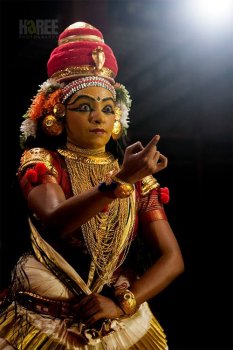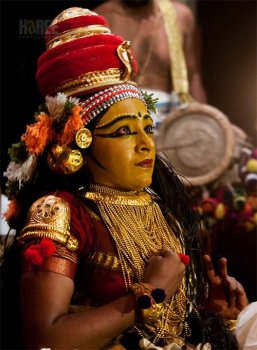
|   |

|   |
Poothana getting salvation Text & pics: Hareesh N Nampoothiri e-mail: newn.haree@gmail.com September 14, 2013 This year’s Krishna Janmashtami was special for those who are familiar with Evoor Sri Krishna Temple, near Harippad, in Kerala. After a long gap of more than 30 years, the authorities decided to bring Nangiarkoothu back to the temple. Kapila Venu, one among the leading Nangiarkoothu performers, was the artiste chosen for the evening. The story was Poothanamoksham which required no detailing, especially for the crowd assembled at Evoor, as the story gets frequent stages there in the form of Kathakali. However, G Venu (Koodiyattam exponent and father/mentor of Kapila) explained the nuances to the audience, when it comes to a Nangiarkoothu presentation. Kapila Venu did not have the luxury of time as the program got a delayed start and there was a full-night Kathakali to be presented afterward. She was forced to trim her presentation to suit the situation. Poothana, disguised as a beautiful woman, reaches Ambadi to execute Kamsa's order to slay all the newborn babies. Kapila skipped the early portions in which the artiste details the scenes of Ambadi as seen by Poothana. Instead, she started with Poothana searching for the newborns. 

Poothana finds a house with a newborn baby and waits for the mother to leave her child. As Gopika, the mother, leaves for milking the cow, Poothana enters the house and starts feeding the baby with poison. The possibilities of pakarnattam were put into good use here to portray this episode. In turn, Kapila acted the part of Poothana, the Gopika and also the playful calf. On the downside, Kapila's Poothana seemed genuinely feminine and the cruel face of the demoness was never to be seen. Whether Poothana killed all the babies by feeding poison is also something which is debatable. (Common understanding is that Poothana decides to feed Krishna with poison, as it was not very easy for her to kill him with bare hands, as she did others). But, when it comes to Nangiarkoothu, it is not only Kapila who follows this traditional way of presentation. As the mother returns, Poothana leaves the child in the cradle and waits outside the house. The mother finds her child sleeping for so long, tries to wake him up and breaks down into tears as she finds her baby is never going to wake up. Kapila was successful in transferring the agony and pain of that poor mother to the keen audience. Upon hearing the cries from inside, a contented Poothana moves on in search of her next prey. Normally, the performers used to enact a few more instances of Poothana killing babies. But here, the lack of time forced Kapila to move straight to the final scene. Poothana finds little Krishna himself in the next house. As soon as she sees the child, she experiences a motherly affection towards him and decides not to kill him. At the same time, she also had the fear that if she failed in her duty, her death in the hands of Kamsa is certain. After an inner struggle she decides to kill him by feeding poison and Krishna grants her salvation. Kapila's portrayal of the emotional conflict of Poothana and the death of the demoness were almost near to perfection. Instead of overdoing the final moments, she resorted to a fine and controlled act which was well appreciated at the end by the audience. In the initial introduction, Venu G hinted that these sequences were originally choreographed by late Guru Ammannoor Madhava Chakyar. Kalamandalam Rajeev and Kalamandalam Hariharan were the percussionists who supported the actor on mizhavu while Kalamandalam Unnikrishnan was on thimila. The program was sponsored by Thinkpot Productions as an offering to the deity. Hareesh N Nampoothiri is a visual design consultant by profession and a lover of classical art forms. Being an ardent follower of Kathakali, he conceptualized and directed a documentary on Kathakali titled 'Thouryathrikam,' which introduces the nuances of Kathakali to the common man. Writing and photography are his other passions. |